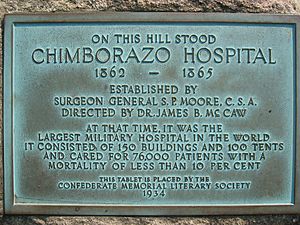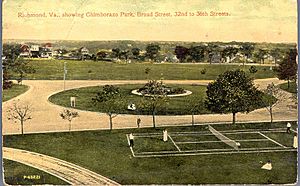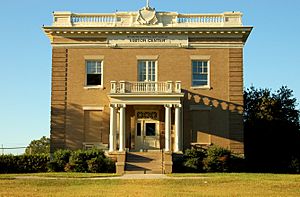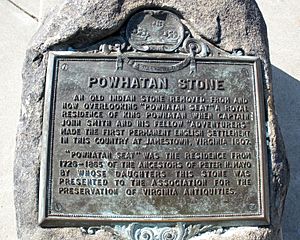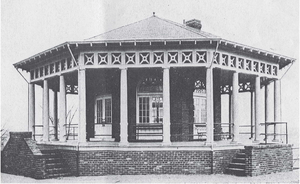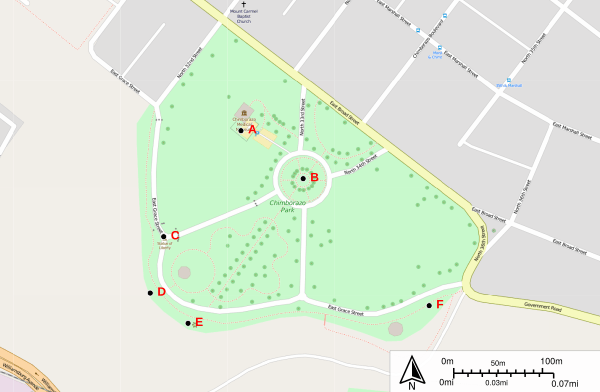Chimborazo Park facts for kids
Quick facts for kids Chimborazo Park |
|
|---|---|
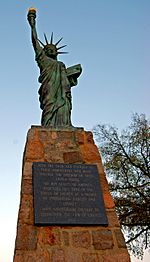
Strengthen the Arm of Liberty
|
|
| Type | Public Park |
| Location | 3201 E. Broad Street Richmond Virginia United States |
| Created | 1874 |
|
Oakwood-Chimborazo Historic District
|
|
| Lua error in Module:Location_map at line 416: Malformed coordinates value. | |
| NRHP reference No. | 04001372 |
| Significant dates | |
| Added to NRHP | March 18, 2005 |
Chimborazo Park is a historic park in Richmond, Virginia, United States. It was created in 1874. Before it became a park, this land was home to Chimborazo Hospital. This hospital was one of the largest military hospitals in the world during the American Civil War.
Contents
What's in a Name?
The name Chimborazo comes from a tall volcano in Ecuador. People believe the Richmond hill got its name around 1802. This was when a famous explorer, Alexander von Humboldt, tried to climb the real Chimborazo volcano.
A local traveler might have named the hill because it looked like the Ecuadorian volcano. There was even a brewery that dug cellars into the hill. These cellars had a hole at the top that acted like a chimney. If there was a fire in the cellar, smoke would billow out. This made the hill look like a small volcano, like Mount Vesuvius!
Before the Civil War, Chimborazo Hill was a common area. Cows grazed there, and kids played ball and flew kites. Sometimes, different groups of boys would even have "rock-battles" there.
Later, the hill was used to gather soldiers coming into Richmond. When the Civil War began, many regiments camped there. They built wooden barracks for shelter. When these soldiers left for battle, they left behind nearly 100 wooden buildings. These buildings were then used to create the famous Chimborazo Hospital.
Chimborazo Hospital: A Giant of Its Time
Chimborazo Hospital was a huge hospital built in Richmond, Virginia, during the American Civil War. It was built to help injured soldiers from the Confederate Army. The hospital was open from 1862 to 1865. It treated over 76,000 injured Confederate soldiers.
What's amazing is that it had a very low death rate for its time, only 9 percent. Today, the land where the hospital stood is owned by the National Park Service. It serves as the visitor center for the Richmond National Battlefield Park.
On the south side of the park, there's a stone monument. It was placed in 1934 to remember the hospital. The stone looks out over the James River. This area was important during the war.
The bronze plaque on the stone says:
|
On this hill stood Established by Surgeon General S.P. Moore, C.S.A. At that time, it was the largest military hospital in the world. It consisted of 150 buildings and 100 tents and cared for 76,000 patients with a mortality of less than 10 per cent. This tablet is placed by the |
A New Beginning: Freedmen's Community
After the Civil War ended, Chimborazo Hospital became a refuge camp. This camp was for former slaves, now known as freedmen. The Freedmen's Bureau managed the camp. Many of the hospital buildings were used as a day school. Other buildings were taken apart for wood to build new homes or for firewood.
However, this community didn't last long. The refuge camp closed soon after it opened. In March 1866, the Freedmen's Bureau told all able-bodied men to leave the park by April 1. Over time, the City of Richmond bought the land bit by bit. They slowly removed the freedmen's community from Chimborazo Hill. The last wooden houses were sold off in 1880. This cleared the way for Chimborazo Park.
Creating Chimborazo Park
On October 26, 1874, Richmond's city leaders decided to buy 35 acres on Chimborazo Hill. They paid $35,000 for the land. A report explained why public parks were so important:
Public parks are not just for making a city look pretty. They are also very good for public health. They help everyone, even the poorest citizens. Parks also make the city richer. As cities get more crowded, these open spaces will become very valuable.
A public park is like a bigger version of our small city squares. Every city that wants to grow and be comfortable needs a park. It shows how successful and cultured a city is.
The city leaders agreed to buy the land. They also decided to set aside money each year to take care of the park. This decision was made on November 10, 1874.
One of the first descriptions of the park came in 1880. A local newspaper said the park was changing from "an eyesore to a thing of beauty." It would be especially nice for people arriving in Richmond by boat. The newspaper said that once Chimborazo Park and Libby Hill Park were finished, Richmond would look very charming to visitors.
In 1886, the park was called "as lovely a spot as can be found." Later, it was described as "a park equal in beauty of elevation and perspective to any certainly in this part of the country" (1887). It was also called a "place of popular resort" (1897). Its high location offered "a magnificent view of the river for twelve or fourteen miles" (1900).
To attract people, the city extended a streetcar line to Chimborazo Park. City officials believed the park would help people relax. They thought it would improve their physical and mental health. It would also provide places for fun activities. The park would also create green spaces between factories and homes.
Over the years, several monuments have been placed in the park. Because of its high and important location, some even suggested it for monuments to famous figures like Jefferson Davis and Robert E. Lee.
Chimborazo Park was considered "progressive" early on. It was one of the first parks to ask people not to walk on the grass. It was also the first in the city to open a public playground. And it was the first to show free movies for everyone.
Today, the park covers 27.9 acres owned by the City of Richmond. An additional 5.6 acres are owned by the federal government. The park and nearby areas are part of the Oakwood–Chimborazo Historic District. This district was added to the Virginia Landmarks Register in 2004 and the National Register of Historic Places in 2005.
Chimborazo Medical Museum
The Chimborazo Medical Museum is located in the northwest part of Chimborazo Park. It focuses on the medical story of the Confederacy. The museum has exhibits on old medical equipment and what hospital life was like. You can also learn about the men and women who worked at Chimborazo Hospital.
The building where the museum is located was first built as a weather station in 1909. The U.S. Weather Bureau used it to record local weather. They also tracked extreme weather events there from 1910 to 1953. The hottest temperature ever recorded there was 107 degrees on August 6, 1918. In 1954, the federal government gave the building to the City of Richmond.
Richmond thought about using the building for many things. These included a health clinic or a community center. In 1957, Richmond gave the building back to the federal government. It is now the headquarters for the Richmond National Battlefield Park. This park is managed by the National Park Service.
Powhatan Stone
On the south side of the park, you can find the "Powhatan Stone." It overlooks the James River. This stone remembers King Powhatan and his relationship with Captain John Smith. Smith was part of the first English settlement in Jamestown. The Association for the Preservation of Virginia Antiquities placed the stone in the park in the 1950s.
The Mayo family, who were descendants of Richmond's first surveyor, William Mayo, lived nearby. Their home was called "Powhatan’s Seat." This was likely where Powhatan's own tribe had a village. The Mayo family kept a special stone at their house. It was said to be part of Powhatan's house. The stone was moved to the park around 1911.
A bronze plaque on the stone says:
| Powhatan Stone An old Indian Stone removed from and now overlooking "Powhatan Seat" a royal residence of King Powhatan when Captain John Smith and his fellow "adventurers" made the first permanent English settlement in this country at Jamestown, Virginia 1607. "Powhatan Seat" was the residence from 1726-1865 of the ancestors of Peter H. Mayo by whose daughters this stone was presented to the Association for the Preservation of Virginia Antiquities.;; |
Statue of Liberty Replica
A smaller copy of the Statue of Liberty was placed in Chimborazo Park on February 11, 1951. It was a gift to the city from the Boy Scouts of the Robert E. Lee Council. This was part of a national effort called "Strengthen the Arm of Liberty”.
A man named Jack P. Whitaker came up with the idea. He had the first replica made and sold copies to Boy Scout councils. Richmond's statue was number 136. A local store paid for the statue. Every Boy Scout in the council gave 25 cents. Their names were put on scrolls inside the statue's base.
The dedication ceremony was a big event. It included the mayor of Richmond, a high school band, and 3,000 people.
A marker on the statue reads:
|
With the faith and courage of their forefathers who made possible the freedom of these United States the Boy Scouts of America dedicated this copy of the Statue of Liberty as a pledge of everlasting fidelity and loyalty 40th anniversary crusade to Strengthen the Arm of Liberty |
Chimborazo Round House
On the east side of the park, you'll find the Chimborazo Round House. It was built in 1915. This building was originally a "comfort station" (a public restroom) and a park house. It replaced two older buildings that were on the same spot.
The first building there was the Chimborazo Pavilion, built in 1905. It had a large porch and a bandstand. The city wanted to make the park more fun. So, they used the pavilion for concerts and public events. Later, a nearby concession stand was turned into a park house to store tools.
A few years later, both the pavilion and the old concession stand were torn down. The materials were used to build a new comfort station and park house in 1910. It's believed that this 1910 building burned down. It was then replaced by the octagonal (eight-sided) building you see today.
Chimborazo Fountain
In the middle of the park, there's an empty circle. This is where an iron fountain once stood. The Chimborazo Fountain was built in 1909. It got its water from a spring under the park. At night, colored lights shone from under the flowing water.
However, to light the fountain, electrical poles were put up through the center of the park. This made the fountain look less grand. In 1910, engineers fixed this problem. They took the fountain apart and buried the wires underground. The city also added a nice iron fence and a concrete walkway around the fountain. The colorful lights of the fountain were a popular sight for many years.
By 1956, the fountain was rusty, and its wiring was broken. The fountain was removed from Chimborazo Park. This left the central circle empty.
Images for kids
Map


